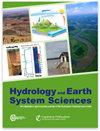基于卫星遥感的蒸散估计的不确定性评估:对方法和差距的系统审查
IF 5.8
1区 地球科学
Q1 GEOSCIENCES, MULTIDISCIPLINARY
引用次数: 2
摘要
摘要。卫星遥感(RS)数据越来越多地被用于估算大面积区域的总蒸发量(通常称为蒸散量(ET))。由于基于 RS 的蒸散量(RS-ET)估算继承了多个来源的不确定性,许多现有研究都采用不同的方法对这些不确定性进行了评估。然而,方法和参考数据的适用性会影响这些评估的有效性。本研究总结了用于 RS-ET 估计值不确定性评估的各种方法的现状,讨论了这些方法的进步和注意事项,确定了评估差距,并为今后的研究提供了建议。我们系统回顾了 2011 年至 2021 年间发表的 676 篇评估 RS-ET 估计值不确定性或准确性的研究论文。我们根据 (i) 用于评估不确定性的方法、(ii) 评估不确定性的背景以及 (iii) 用于报告不确定性的指标对这些论文进行了分类和归类。我们的定量综合分析表明,RS-ET 估计值的不确定性评估在方法、参考数据、地理分布和不确定性表述方面并不一致,也不具有可比性。大多数研究采用基于涡度-协方差(EC)的蒸散发估算值作为参考的验证方法。然而,在非洲和中东等许多地区,由于缺乏涡度协方差站,通常使用其他参考数据。RS-ET 估计值的精度和不确定性通常用均方根误差(RMSE)来描述。在与基于 EC 的估计值进行验证时,RS-ET 日均方误差在不同地点和不同时间支持水平之间差异很大,从 0.01 到 6.65 mm d-1,平均为 1.18 mm d-1。我们的结论是,未来的研究需要报告验证的背景、参考数据集的不确定性、参考数据集与 RS-ET 估计的时空尺度的不匹配,以及多种性能指标在不同条件下的变化及其统计意义,以便为潜在用户提供全面的解释。我们就此提出了具体建议。此外,要将 RS-ET 的应用扩展到缺乏验证的地区,需要获取更多的地面数据,并结合不同的方法进行不确定性评估。本文章由计算机程序翻译,如有差异,请以英文原文为准。
Uncertainty assessment of satellite remote-sensing-based evapotranspiration estimates: a systematic review of methods and gaps
Abstract. Satellite remote sensing (RS) data are increasingly being used to estimate total evaporation, often referred to as evapotranspiration (ET), over large regions. Since RS-based ET (RS-ET) estimation inherits uncertainties from several sources, many available studies have assessed these uncertainties using different methods. However, the suitability of methods and reference data subsequently affects the validity of these evaluations. This study summarizes the status of the various methods applied for uncertainty assessment of RS-ET estimates, discusses the advances and caveats of these methods, identifies assessment gaps, and provides recommendations for future studies. We systematically reviewed 676 research papers published from 2011 to 2021 that assessed the uncertainty or accuracy of RS-ET estimates. We categorized and classified them based on (i) the methods used to assess uncertainties, (ii) the context where uncertainties were evaluated, and (iii) the metrics used to report uncertainties. Our quantitative synthesis shows that the uncertainty assessments of RS-ET estimates are not consistent and comparable in terms of methodology, reference data, geographical distribution, and uncertainty presentation. Most studies used validation methods using eddy-covariance (EC)-based ET estimates as a reference. However, in many regions such as Africa and the Middle East, other references are often used due to the lack of EC stations. The accuracy and uncertainty of RS-ET estimates are most often described by root-mean-squared errors (RMSEs). When validating against EC-based estimates, the RMSE of daily RS-ET varies greatly among different locations and levels of temporal support, ranging from 0.01 to 6.65 mm d−1, with a mean of 1.18 mm d−1. We conclude that future studies need to report the context of validation, the uncertainty of the reference datasets, the mismatch in the temporal and spatial scales of reference datasets to those of the RS-ET estimates, and multiple performance metrics with their variation in different conditions and their statistical significance to provide a comprehensive interpretation to assist potential users. We provide specific recommendations in this regard. Furthermore, extending the application of RS-ET to regions that lack validation will require obtaining additional ground-based data and combining different methods for uncertainty assessment.
求助全文
通过发布文献求助,成功后即可免费获取论文全文。
去求助
来源期刊

Hydrology and Earth System Sciences
地学-地球科学综合
CiteScore
10.10
自引率
7.90%
发文量
273
审稿时长
15 months
期刊介绍:
Hydrology and Earth System Sciences (HESS) is a not-for-profit international two-stage open-access journal for the publication of original research in hydrology. HESS encourages and supports fundamental and applied research that advances the understanding of hydrological systems, their role in providing water for ecosystems and society, and the role of the water cycle in the functioning of the Earth system. A multi-disciplinary approach is encouraged that broadens the hydrological perspective and the advancement of hydrological science through integration with other cognate sciences and cross-fertilization across disciplinary boundaries.
 求助内容:
求助内容: 应助结果提醒方式:
应助结果提醒方式:


